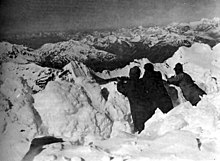
Back Guerra Blanca Catalan Horská válka 1915–1918 Czech Gebirgskrieg 1915–1918 German Guerra Bianca Italian Războiul din munți 1915–1918 Romanian Vita kriget Swedish
| White War | |||||||
|---|---|---|---|---|---|---|---|
| Part of Italian front (World War I) | |||||||
 Clockwise from above: Austrian barracks in East Tyrol; Alpine with mule painting by Achille Beltrame from 1916; Austrian infantrymen waiting for the ration in the sector of Dreisprachenspitze; difficult transport of an Italian artillery piece at high altitude | |||||||
| |||||||
| Belligerents | |||||||
|
|
| ||||||
| Commanders and leaders | |||||||
|
|
| ||||||
| Strength | |||||||
| Two armies for about 100–120,000 men | April 1915: about 32,400 Austro-Hungarians defending the Tyrol + 13 battalions of the German Alpenkorps arrived on May 26, 1915 | ||||||
| Casualties and losses | |||||||
| c. 150,000–180,000 overall deaths, only one third of which were caused by combat[1] | |||||||

The White War (Italian: Guerra Bianca, German: Gebirgskrieg, Hungarian: Fehér Háború)[2][3] is the name given to the fighting in the high-altitude Alpine sector of the Italian front during the First World War, principally in the Dolomites, the Ortles-Cevedale Alps and the Adamello-Presanella Alps. More than two-thirds of this conflict zone lies at an altitude above 2,000m, rising to 3905m at Mount Ortler.[4][5] In 1917 New York World correspondent E. Alexander Powell wrote: “On no front, not on the sun-scorched plains of Mesopotamia, nor in the frozen Mazurian marshes, nor in the blood-soaked mud of Flanders, does the fighting man lead so arduous an existence as up here on the roof of the world.”[6]
- ^ Heinz von Lichem, Der einsame Krieg, p. 240
- ^ "Museo della Guerra Bianca in Adamello". museoguerrabianca.it. Museo della Guerra Bianca in Adamello. Retrieved 13 September 2020.
- ^ Heinz Lichem von Löwenbourg (1980). Gebirgskrieg 1915–1918. Athesia. ISBN 978-88-7014-175-7. Retrieved 1 October 2015.
{{cite book}}: Unknown parameter|agency=ignored (help) - ^ Gravino, Michele (18 October 2014). "A Century Later, Relics Emerge From a War Frozen in Time". nationalgeographic.com. National Geographic. Archived from the original on August 12, 2019. Retrieved 19 September 2020.
- ^ Dunlap, David (20 September 2017). "The Awful Beauty of the 'White War'". The New York Times. Retrieved 19 September 2020.
- ^ Mockenhaupt, Brian. "The Most Treacherous Battle of World War I Took Place in the Italian Mountains". smithsonianmag.com. Smithsonian Museum. Retrieved 19 September 2020.